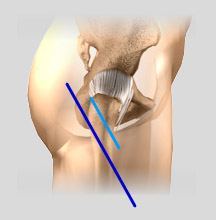Dr. Makda provided EXCEPTIONAL care to my father for his knee replacements.
Dr. Makda provided EXCEPTIONAL care to my father for his knee replacements. His attention to his patients and willingness to explain the treatment pla...

The hip joint is one of the body's largest weight-bearing joints and is the point where the thigh bone (femur) and the pelvis (acetabulum) join. It is a ball and socket joint in which the head of the femur is the ball and the pelvic acetabulum forms the socket. The joint surface is covered by a smooth articular cartilage that cushions and enables smooth movements of the joint.
Hip arthritis is one of the painful and common diseases of the hip joint caused by damage to the cartilage. Total hip replacement surgery is an option to relieve severe arthritis pain that limits your daily activities.
Traditionally, total hip replacement will be performed through a 10 to 12-inch-long incision made on the side of the hip. A minimally invasive approach has been developed in recent years where surgery is performed through one or two smaller incisions rather than the single long incision as in the traditional approach. Advantages of the newer approach are lesser muscle dissection, minimal pain, quicker recovery, and faster rehabilitation.
Arthritis is inflammation of the joints resulting in pain, swelling, stiffness and limited movement. Hip arthritis is a common cause of chronic hip pain and disability. The most common type of arthritis affecting the hip is osteoarthritis which is characterized by progressive wearing away of the joint cartilage. As the protective cartilage wears down, the bone ends rub against each other and cause pain in the hip. It is more common in individuals aged above 50 years and tends to run in families.
The most common symptom of hip arthritis is dull, aching joint pain and stiffness resulting in limited mobility. There may be pain in the groin, thigh and buttock area and sometimes pain may be referred to the knee. Vigorous activity and walking for long distances can increase the pain and stiffness which may cause limping while walking.
Diagnosis is made by evaluating your symptoms, medical history, physical examination and X-rays. Sometimes, additional imaging tests such as MRI and CT scans may needed to confirm the diagnosis.
Surgery may be recommended in patients with severe cartilage damage and if conservative treatment options such as anti-inflammatory medications and physical therapy do not relieve the symptoms.
For minimally invasive hip replacement, the surgical technique and artificial implants remain the same as traditional hip replacement however the difference is smaller incisions and minimal soft tissue dissection. The surgery is performed through either one or two smaller incisions. The procedure is performed under general anesthesia.
In single incision minimally invasive approach, your surgeon makes a 3 to 6-inch incision over the side of the hip to expose the hip joint. The muscles are minimally dissected to reach the joint. The femur is dislocated from the acetabulum. The surface of the socket is cleaned, and the arthritic bone is removed using a reamer. The acetabular implant is inserted into the socket using screws or special cement. A liner material of plastic, ceramic or metal is placed inside the acetabular component. The femur or thigh bone is then prepared by removing the arthritic bone using special instruments and shaped to exactly fit the new metal femoral component. The femoral stem is then inserted into the femur either by a press fit or using bone cement. Then the femoral head component made of metal or ceramic is placed on the femoral stem. All the new parts are secured in place using special cement. The muscles and tendons around the new joint are repaired and the incision is closed.
If the surgeon uses the two-incision technique, a 2- to 3-inch incision is made over the groin for placement of the socket and a 1- to 2-inch incision is made over the buttock for placement of the femoral stem. This technique requires longer operative time and is performed under X-ray guidance.
The advantages of minimally invasive total hip replacement as compared with traditional total hip replacement may include:
After undergoing minimally invasive total hip replacement, you must take special care to prevent dislocation of the new joint and to ensure proper healing.
As with any major surgical procedure, there are certain potential risks and complications involved with total hip replacement surgery. They include:
Dr. Makda provided EXCEPTIONAL care to my father for his knee replacements.
Dr. Makda provided EXCEPTIONAL care to my father for his knee replacements. His attention to his patients and willingness to explain the treatment pla...
I had needed knee replacements for quite awhile.
I had needed knee replacements for quite awhile. I even saw other doctors about it but never moved forward as I realized now it all was never explaine...
Dr. Makda is wonderful. He is kind, very knowledgeable and offers different types of recovery for knee problems. After 3 visits I was released from ca...
My left knee was replaced in the hands of Dr Makda last July
My left knee was replaced in the hands of Dr Makda last July. Now my right hip in 2 weeks (mid April 2019).
All went as expected. Have to do all the therapy if you want to recover fast.
All went as expected. Have to do all the therapy if you want to recover fast. Very happy with my new left knee.
100 Village Green Drive
Suite 120
Lincolnshire, IL 60069